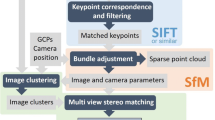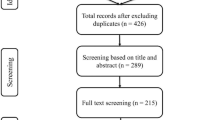Abstract
Key message
Use of ground-penetrating radar (GPR) can non-destructively estimate diameter and distribution of coarse roots in Cryptomeria japonica in weathered granite soils under field conditions.
Abstract
Ground-penetrating radar (GPR) has been used as an assessment tool for non-destructive detection of tree root biomass, but few studies have estimated root diameter under forest field conditions. The aim of this study was to clarify whether coarse root diameter of C. japonica in weathered granite soils can be estimated using GPR in a forest. Roots of mature C. japonica were scanned using a 900 MHz GPR antenna before being excavated. The diameter and distribution of excavated roots were compared with those identified by GPR, and the relationships between the diameter and waveform indices in radar profiles were also examined. The detection frequency of the number of roots larger than 5 mm in diameter was 47.7%. Limiting factors affecting root detection using GPR in forest field conditions were small root diameter, increasing root depth, and number of adjacent roots. Only one waveform index, using the sum of time intervals between zero crossings (ΣT, ns) of all reflection waveforms of GPR within the range from the first break time at the root top to the delay point time at the root bottom, had a significant relationship with excavated root diameters. A linear regression model was constructed to estimate root diameter using ΣT, and a significant positive relationship in diameter between GPR-estimated and excavated roots was confirmed. The results in this study indicate that the diameter and distribution of C. japonica coarse roots under forest field conditions could be estimated using GPR and this technique could contribute to future evaluation of slope stability by evaluating tree roots under vulnerable soils, such as weathered granite.



(modified from Tanikawa et al. 2016). a Representative reflected hyperbola in a radar profile of a root at a depth of 23 cm; b reflection waveforms and the four waveform parameters extracted in this study




Similar content being viewed by others
References
Bain JC, Day FP, Butnor JR (2017) Experimental evaluation of several key factors affecting root biomass estimation by 1500 MHz ground-penetrating radar. Remote Sens 9:1337. https://doi.org/10.3390/rs9121337
Barton CV, Montagu KD (2004) Detection of tree roots and determination of root diameters by ground penetrating radar under optimal conditions. Tree Physiol 24:1323–1331. https://doi.org/10.1093/treephys/24.12.1323
Borden KA, Isaac ME, Thevathasan NV, Gordon AM, Thomas SC (2014) Estimating coarse root biomass with ground penetrating radar in a tree-based intercropping system. Agroforest Syst 88:657–669. https://doi.org/10.1007/s10457-014-9722-5
Borden KA, Thomas SC, Isaac ME (2016) Interspecific variation of tree root architecture in a temperate agroforestry system characterized using ground-penetrating radar. Plant Soil 410:323–334. https://doi.org/10.1007/s11104-016-3015-x
Butnor JR, Doolittle JA, Kress L, Cohen S, Johnsen KH (2001) Use of ground-penetrating radar to study tree roots in the southeastern United States. Tree Physiol 21:1269–1278
Butnor JR, Doolittle JA, Johnsen KH, Samuelson L, Stocks T, Kress L (2003) Utility of ground-penetrating radar as a root biomass survey tool in forest systems. Soil Sci Soc Am J 67:1607–1615
Butnor JR, Barton C, Day FP, Johnsen KH, Mucciardi AN, Schroeder R, Sover DB (2012) Using ground-penetrating radar to detect tree roots and estimate biomass. In: Mancuso S (ed) Measuring roots, an updated approach. Springer, Berlin, pp 213–245
Butnor JR, Samuelson LJ, Stokes TA, Johnsen KH, Anderson PH, Gonzalez-Benecke CA (2016) Surface-based GPR underestimate below-stump root biomass. Plant Soil 402:47–62. https://doi.org/10.1007/s11104-015-2768-y
Chang CH (2011) Preparedness and storm hazards in a global warming world: lessons from Southeast Asia. Nat Hazards 56:667–669. https://doi.org/10.1007/s11069-010-9581-y
Chigira M, Mohamad Z, Sien LC, Komoo I (2011) Landslides in weathered granitic rocks in Japan and Malaysia. Bull Geol Soc Malaysia 57:1–6. https://doi.org/10.7186/bgsm2011001
Cox KD, Scherm H, Serman N (2005) Ground-penetrating radar to detect and quantify residual root fragments following peach orchard clearing. Hort Technol 15:600–607
Cui X, Chen J, Shen J, Cao X, Chen X, Zhu X (2011) Modeling tree root diameter and biomass by ground-penetrating radar. Sci China Earth Sci 54:711–719. https://doi.org/10.1007/s11430-010-4103-z
Cui X, Guo L, Chen J, Chen X, Zhu X (2013) Estimating tree-root biomass in different depths using ground-penetrating radar: evidence from a controlled experiment. IEEE Trans Geosci Remote Sens 51:3410–3423. https://doi.org/10.1109/TGRS.2012.2224351
Danjon F, Reubens B (2008) Assessing and analyzing 3D architecture of woody root systems, a review of methods and applications in tree and soil stability, resource acquisition and allocation. Plant Soil 303:1–34. https://doi.org/10.1007/s11104-007-9470-7
Dannoura M, Hirano Y, Igarashi T, Ishii M, Aono K, Yamase K, Kanazawa Y (2008) Detection of Cryptomeria japonica roots with ground penetrating radar. Plant Biosyst 142:375–380
FAO-UNESCO (1994) Soil map of the world, revised legend 1990. World soil resources report 60. FAO, Rome
Forest Agency of Japan (2012) Annual report on forest and forestry in Japan for FY2013. http://www.rinya.maff.go.jp/j/kikaku/hakusyo/23hakusyo/pdf/honbun1-3.pdf Accessed 4 Dec 2017
Forest Soils Division (1976) Classification of forest soils in Japan, vol 280. Bull Gov For Exp Sta, Tokyo, pp 1–28
Genet M, Kokutse N, Stokes A, Fourcaud T, Cai X, Ji J, Mickovski SB (2008) Root reinforcement in plantations of Cryptomeria japonica D. Don: effect of tree age and stand structure on slope stability. For Ecol Manag 256:1517–1526. https://doi.org/10.1016/j.foreco.2008.05.050
Guo L, Chen J, Cui X, Fan B, Lin H (2013a) Application of ground penetrating radar for coarse root detection and quantification: a review. Plant Soil 362:1–23. https://doi.org/10.1007/s11104-012-1455-5
Guo L, Lin H, Fan B, Cui X, Chen J (2013b) Impact of root water content on root biomass estimation using ground penetrating radar: evidence from forward simulation and field controlled experiments. Plant Soil 371:503–520. https://doi.org/10.1007/s11104-013-1710-4
Guo L, Wu Y, Chen J, Hirano Y, Tanikawa T, Li W, Cui X (2015) Calibrating the impact of root orientation on root quantification using ground-penetrating radar. Plant Soil 395:289–305. https://doi.org/10.1007/s11104-015-2563-9
Hagrey SA (2012) Geophysical imaging techniques. In: Mancuso S (ed) Measuring roots, an updated approach. Springer, Berlin, pp 151–158
Hirano Y, Dannoura M, Aono K, Igarashi T, Ishii M, Yamase K, Makita N, Kanazawa Y (2009) Limiting factors in the detection of tree roots using ground-penetrating radar. Plant Soil 319:15–24. https://doi.org/10.1007/s11104-015-2563-9
Hirano Y, Yamamoto R, Dannoura M, Aono K, Igarashi T, Ishii M, Yamase K, Makita N, Kanazawa Y (2012) Detection frequency of Pinus thunbergii roots by ground-penetrating radar is related to root biomass. Plant Soil 360:363–373. https://doi.org/10.1007/s11104-012-1252-1
Hruska J, Cermak J, Sustek S (1999) Mapping tree root systems with ground-penetrating radar. Tree Physiol 19:125–130
Japan Meteorological Agency (2017a) Long-term change in occurrence frequency of torrential rain for a short time. http://www.jma.go.jp/jma/kishou/info/heavyraintrend.html Accessed 11 Dec 2017
Japan Meteorological Agency (2017b) Past weather data. http://www.data.jma.go.jp/obd/stats/etrn/. Accessed 4 Dec 2017
Liu Q, Cui X, Liu X, Chen X, Cao X (2017) Detection of root orientation using ground-penetrating radar. IEEE Trans Geosci Remote Sens 56:93–104. https://doi.org/10.1109/TGRS.2017.2737003
Liu X, Dong X, Xue Q, Leskovar DI, Jifon J, Butnor JR, Marek T (2018) Ground penetrating radar (GPR) detects fine roots of agricultural crops in the field. Plant Soil. https://doi.org/10.1007/s11104-017-3531-3
Noguchi K, Konôpka B, Satomura T, Kaneko S, Takahashi M (2007) Biomass and production of fine rots in Japanese forests. J For Res 12:83–95. https://doi.org/10.1007/s10310-006-0262-3
Ohashi M, Kakizoe T, Ikeno H, Yamase K, Tanikawa T, Dannoura M, Aono K, Todo C, Hirano Y (2016) Detection of horizontal root distribution of a black pine in a sea coast by concentrically searching of ground penetrating radar. J Jpn Soc Reveget Tech 41:385–390 (in Japanese with English summary)
Petley D (2010) On the impact of climate change and population growth on the occurrence of fatal landslides in South, East and SE Asia. Q J Eng Geol Hydrogeol 43:487–496. https://doi.org/10.1144/1470-9236/09-001
Pollen N, Simon A (2005) Estimating the mechanical effects of riparian vegetation on stream bank stability using a fiber bundle model. Water Resour Res 41:W07025. https://doi.org/10.1029/2004WR003801
R Core Team (2017) R: a language and environment for statistical computing. T Foundation for Statistical Computing, Vienna Austria. https://www.r-project.org/. Accessed 7 Sep 2017
Reubens B, Poesen J, Danjon F, Geudens G, Muys B (2007) The role of fine and coarse roots in shallow slope stability and soil erosion control with a focus on root system architecture: a review. Trees 21:385–402. https://doi.org/10.1007/s00468-007-0132-4
Samuelson LJ, Butnor JR, Maier C, Stokes TA, Johnsen K, Kane M (2008) Growth and physiology of loblolly pine in response to long-term response management: defining growth potential in the southern United State. Can J For Res 38:721–732. https://doi.org/10.1139/X07-191
Samuelson LJ, Stocks TA, Butnor JR, Johnson KH, Gonzalez-Beneche CA, Anderson P, Jackson J, Ferrari L, Martin TA, Cropper WP Jr (2014) Ecosystem carbon stocks in Pinus palustris Mill. forests. Can J For Res 44:476–486. https://doi.org/10.1139/cjfr-2013-0446
Schwarz M, Lehmann P, Or D (2010) Quantifying lateral root reinforcement in steep slopes—from a bundle of roots to tree stands. Earth Surf Process Landforms 35:354–367. https://doi.org/10.1002/esp.1927
Stover DB, Day FP, Butnor JR, Bert G, Drake BG (2007) Effect of elevated CO2 on coarse-root biomass in Florida scrub detected by ground-penetrating radar. Ecology 88:1328–1334
Suzuki S, Yoshitake T, Goto Y (2009) Values for forest damage caused by strong wind, heavy rain, snow and forest fire based on statistics compiled in Japan fiscal year 1954 to 2003. Bull FFPRI 8:71–100 (in Japanese with English summary)
Tanikawa T, Hirano Y, Dannoura M, Yamase K, Aono K, Ishii M, Igarashi T, Ikeno H, Kanazawa Y (2013) Root orientation can affect detection accuracy of ground-penetrating radar. Plant Soil 373:317–327. https://doi.org/10.1046/j.1365-2745.2002.00682.x
Tanikawa T, Dannoura M, Yamase K, Ikeno H, Hirano Y (2014) Reply to: “Comment on root orientation can affect detection accuracy of ground-penetrating radar”. Plant Soil 380:445–450. https://doi.org/10.1007/s11104-014-2136-3
Tanikawa T, Ikeno H, Dannoura M, Yamase K, Aono K, Hirano Y (2016) Leaf litter thickness, but not plant species, can affect root detection by ground penetrating radar. Plant Soil 408:271–283. https://doi.org/10.1007/s11104-016-2931-0
Tobin B, Cermak J, Chiatante D, Danjon F, Di Iorio A, Dupuy L, Eshel A, Jourdan C, Kalliokoski T, Laiho R, Nadezhdina N, Nicoll B, Pages L, Silva J, Spanos I (2007) Towards developmental modelling of tree root systems. Plant Biosyst 141:481–501
Tsuchida T, Moriwaki T, Kumamoto N, Ichii K, Kano S, Nakai S (2016) Investigation of debris flow and damaged areas of 2014 Hiroshima landslide disaster. Jpn Geotech J 11:33–52 (in Japanese with English summary)
Van Beek LPH, Wint J, Cammeraat LH, Edwards JP (2005) Observation and simulation of root reinforcement on abandoned Mediterranean slopes. Plant Soil 278:55–74. https://doi.org/10.1007/s11104-005-7247-4
Wu TH, McKinnell WP, Swanston DN (1979) Strength of tree roots and landslides on Prince of Wales Island, Alaska. Can Geotech J 16:19–33
Wu Y, Guo L, Cui X, Chen J, Cao X, Lin H (2014) Ground-penetrating radar-based automatic reconstruction of three-dimensional coarse root system architecture. Plant Soil 282:155–172. https://doi.org/10.1007/211104-014-2139-0
Yushkevich PA, Piven J, Hazlett HC, Smith RG, Sean Ho S, Gee JC, Gerig G (2006) User-guided 3D active contour segmentation of anatomical structures: significantly improved efficiency and reliability. Neuroimage 31(3):1116–1128
Acknowledgements
We thank I. Endo (University of Hyogo) for improving the manuscript, and N. Hosohata (KANSO Technos), Y. Maekawa, Y. Nakagawa, A. Takamatsu, M. Yoshida, T. Kakizoe, M. Tojyo, A. Hanada (University of Hyogo), N. Amin, J. An, R. Nakahata (Kyoto University), K. Miyatani, K. Ichikawa (Nagoya University), K. Miyata, M. Hayashida (Miyata Jyugyo), T. Nakagawa, T. Hashimoto (Hyogo Prefectural Technology Center for Agriculture, Forestry and Fisheries) for their invaluable assistance in field and laboratory work. We also thank Y. Shigeto and M. Hata (Kobe City) for permission to use the field site.
Funding
This study was funded partly by Grants-in-Aid for Scientific Research from the Japan Society for the Promotion of Science (Grant number, 25252027).
Author information
Authors and Affiliations
Corresponding author
Ethics declarations
Conflict of interest
The authors declare that they have no conflicts of interest.
Additional information
Communicated by Ernst Van Der Maaten.
Rights and permissions
About this article
Cite this article
Yamase, K., Tanikawa, T., Dannoura, M. et al. Ground-penetrating radar estimates of tree root diameter and distribution under field conditions. Trees 32, 1657–1668 (2018). https://doi.org/10.1007/s00468-018-1741-9
Received:
Accepted:
Published:
Issue Date:
DOI: https://doi.org/10.1007/s00468-018-1741-9




